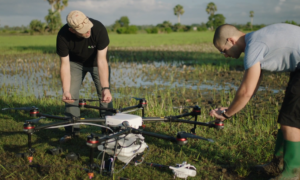According to a now famous blog post by Bill Gates, mosquitoes are by far the deadliest animal on the planet in terms of the number of human lives that they claim through disease:
The worst is malaria, which kills more than 600,000 people every year; another 200 million cases incapacitate people for days at a time. It threatens half of the world’s population and causes billions of dollars in lost productivity annually. Other mosquito-borne diseases include dengue fever, yellow fever, and encephalitis.
It turns out that in addition to commercial applications from mining to agriculture, drones are also an effective way to fight the deadly mosquito. At the African Drone Forum today, DJI Enterprise Product Manager Eduardo Rodríguez described a recent project in Tanzania, using a customized DJI spraying drone to attack mosquitos at the source.
Improvements in malaria death figures have been made by the use of residual spraying and long-lasting insecticide treated nets indoors – but the tide may be turning in the wrong direction, as mosquitos develop resistance to commercial insecticides. “We need to come up with alternative strategies,” said Rodríguez. One of the best new strategies is larval source management (LSM) which kills mosquitoes still in larval stage. There are several reasons why LSM is useful, Rodríguez explained: “First, the mosquitos are concentrated; second, the mosquitos are immobile at this stage of development – they can’t fly away. And lastly, these areas are usually accessible.”
While the larval areas, like rice paddies, are generally accessible, someone has to do the spraying. That means that a farmer is exposed both to insecticides and to malaria-carrying mosquitoes. Researchers have now developed new ways to deal with these challenges: harmful pesticides can be replaced with biodegradable, non-toxic, silicone-based fluid. The fluid spreads by itself and coats the water, trapping the larvae in the water where they breed and drowning them.
The second way of solving these problems is to equip local communities with drone technology: so they can both map the mosquito breeding areas, and then use drones to spray the insecticides. Using drones, said Rodríguez, “is a highly efficient method, even compared to spraying with helicopters… with drones we can easily and quickly map the terrain, calculate the appropriate amount of pesticide, and deliver it. By using spraying drones to deliver the solution, we can improve productivity by more than 100%, covering 50 – 60 hectares a day.”
DJI’s anti-malaria drone is the autonomous Agras MG-1S, an octocopter that can carry a 10 kg payload – 10 liters of insecticide – and is able to maintain a consistant distance over a variable landscape, making it an effective way to deliver spray over crops or for other uses. While generally used for traditional or water-based insecticides, DJI modified the spraying system to accommodate the silicone-based fluid.
“We really can eradicate malaria,” said Rodríguez.
Miriam McNabb is the Editor-in-Chief of DRONELIFE and CEO of JobForDrones, a professional drone services marketplace, and a fascinated observer of the emerging drone industry and the regulatory environment for drones. Miriam has a degree from the University of Chicago and over 20 years of experience in high tech sales and marketing for new technologies.
For drone industry consulting or writing, Email Miriam or (for paid consulting engagements only) request a meeting through AdvisoryCloud:
TWITTER:@spaldingbarker
Subscribe to DroneLife here.
https://dronelife.com/2020/02/07/using-drones-to-combat-the-deadliest-animal-on-the-planet-the-mosquito/
 Unmanned Aerial Vehicle The latest drone news
Unmanned Aerial Vehicle The latest drone news





